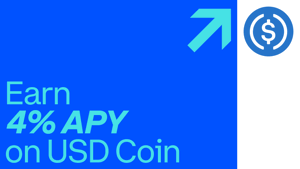Coinbase just announced its Coinbase Savings account product which pays 4% APY on USDC stablecoin deposits. There are several competitors in this area designed to compete against traditional bank savings accounts, even though they aren’t FDIC insured. The important difference here is that Coinbase is the most established and well-capitalized crypto exchange platform in the world. Let’s see how that changes things.
I’ve already explored the potential risks of high-interest stablecoin accounts, but they boil down to:
- Stablecoin price risk. Every US dollar stablecoin is supposed to be backed with $1 of real US dollars and/or cash equivalents in a regulated custodial account, so that you can sell it for $1.00. Stablecoin providers hire independent auditing companies to attest that there are actually enough dollars in bank accounts. Tether is an example of a stablecoin with what I feel is questionable collateral backed by a group that has already lied in the past. USD Coin is partially controlled by Coinbase itself and has a far cleaner history as far as I can tell. You can view the USDC audit reports here done by Grant Thornton LLP.
- Counterparty risk. At an FDIC-insured bank, you give them your dollars and the bank lends it out, but the government promises you’ll get your money back even if the bank fails. There is no FDIC insurance on this account. The guarantee is from Coinbase itself, and the positive news is that Coinbase is the largest cryptocurrency exchange platform in the world and a publicly-listed company on the Nasdaq (ticker COIN) with has a current market cap of $50 billion.
Coinbase also claims that they are safer than the competition because their lending practices are more sound:
We have recently seen the rise of crypto interest accounts that offer attractive rates on customers’ assets. While the high interest rates are appealing, they can present varying levels of risk. When you read the full terms and conditions, you may find that your assets are loaned to unidentified third parties and subject to their credit risk, which could result in a total loss of your crypto holdings.
Coinbase Borrow lets verified owners borrow up to $20,000 backed by their Bitcoin holdings as collateral, with no fees or credit checks. You are allowed to borrow up to 40% of your Bitcoin value at an interest rate of 7.9% APY. Theoretically, that means BTC could drop 60% before the outstanding principal exceeds the collateral, and as long as Coinbase sells before then, Coinbase won’t lose any money. However, that’s not the most important part. You’re not just a asset-backed lender. Coinbase itself as a $50 billion company is also guaranteeing your USDC deposits in the Coinbase Lend program.
Altogether, this makes the Coinbase Lend interest account one of the “safest” stablecoins held and guaranteed by one of the “safest” crypto exchanges. But is that safe enough? Each person will have to decide for themselves. It’s definitely not the same as an FDIC-insured bank, and I like my cash to be as safe and liquid as possible. At the same time, many folks are okay with giving up FDIC-insurance for only 1.35% APY from car demand notes backed by Toyota’s leasing arm. It’s not a question of
“Is it 100% safe?” as much as “Is it safe enough for 4% APY interest?”.
Currently, there is high demand for cash to enter the crypto-world as traditional banks are still avoiding that role, so you may decide to enjoy the arbitrage opportunity while it lasts. Note: “Pre-enrollment is currently available to eligible US residents except those residing in HI & NY.”
New users can open a Coinbase account and get $5 in free Bitcoin after your photo ID is verified. You can even earn $28+ in more free crypto when you learn more about different cryptocurrencies. More are added over time. I would view these as lottery tickets, as perhaps one of them will skyrocket in value. You can do these activities even if you skip the interest account.

 The Best Credit Card Bonus Offers – 2025
The Best Credit Card Bonus Offers – 2025 Big List of Free Stocks from Brokerage Apps
Big List of Free Stocks from Brokerage Apps Best Interest Rates on Cash - 2025
Best Interest Rates on Cash - 2025 Free Credit Scores x 3 + Free Credit Monitoring
Free Credit Scores x 3 + Free Credit Monitoring Best No Fee 0% APR Balance Transfer Offers
Best No Fee 0% APR Balance Transfer Offers Little-Known Cellular Data Plans That Can Save Big Money
Little-Known Cellular Data Plans That Can Save Big Money How To Haggle Your Cable or Direct TV Bill
How To Haggle Your Cable or Direct TV Bill Big List of Free Consumer Data Reports (Credit, Rent, Work)
Big List of Free Consumer Data Reports (Credit, Rent, Work)
Very interesting, thanks Jonathan. I didn’t see anything on the initial page of the site about minimum initial deposit, minimum balance needed to be maintained, or other usual savings account terms – any insight?
I don’t believe Coinbase has rolled out all the details yet. I know they use Plaid to connect bank accounts for ACH transfers for their other services, so I assume there will be free ACH transfer via Plaid for the savings account as well. My guess is that they are going to be similar to other crypto interest accounts, $100 or lower minimum to open and no monthly fees.
what about trade station with 6% rate on usdc. how is it compare to coin